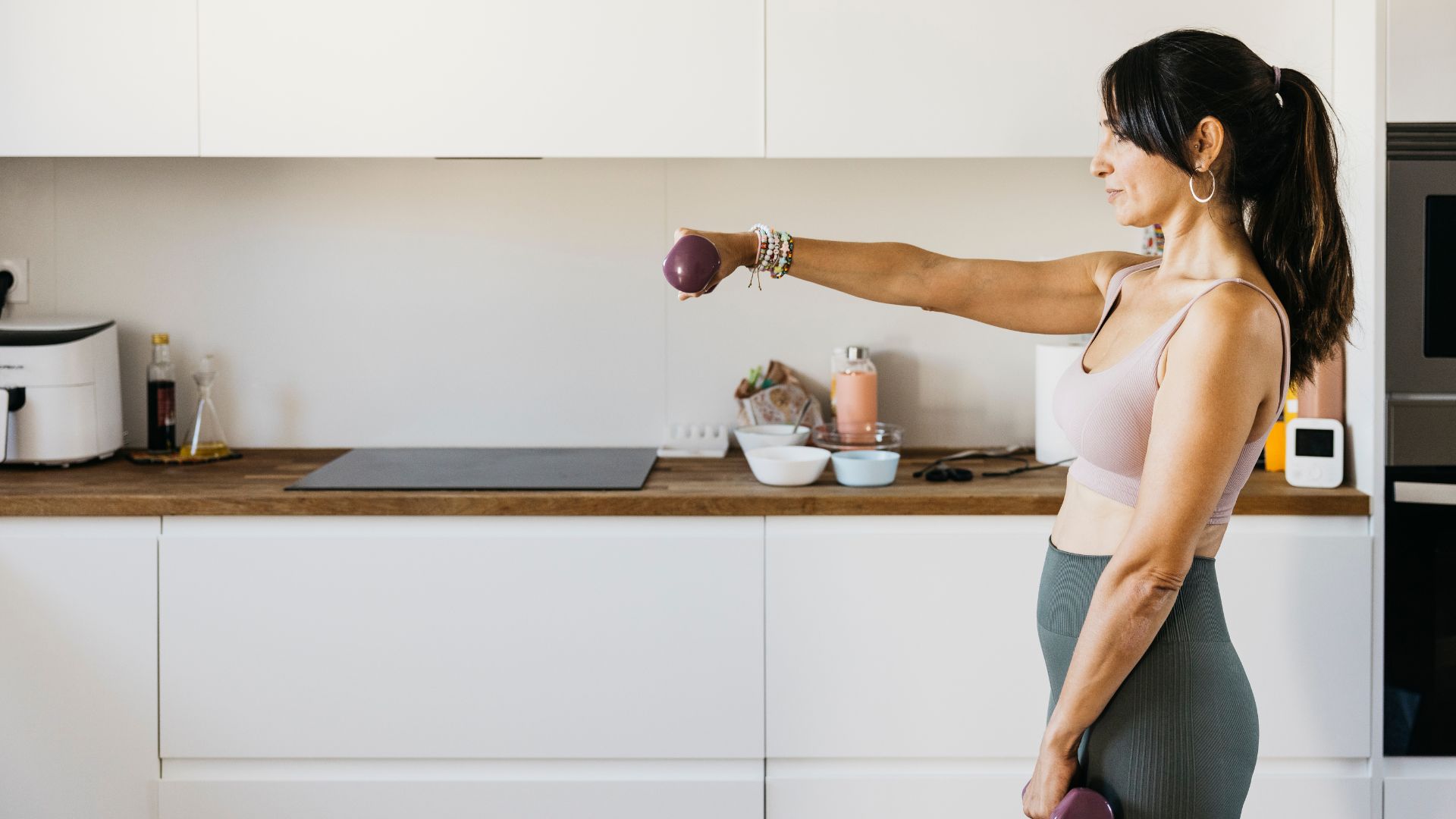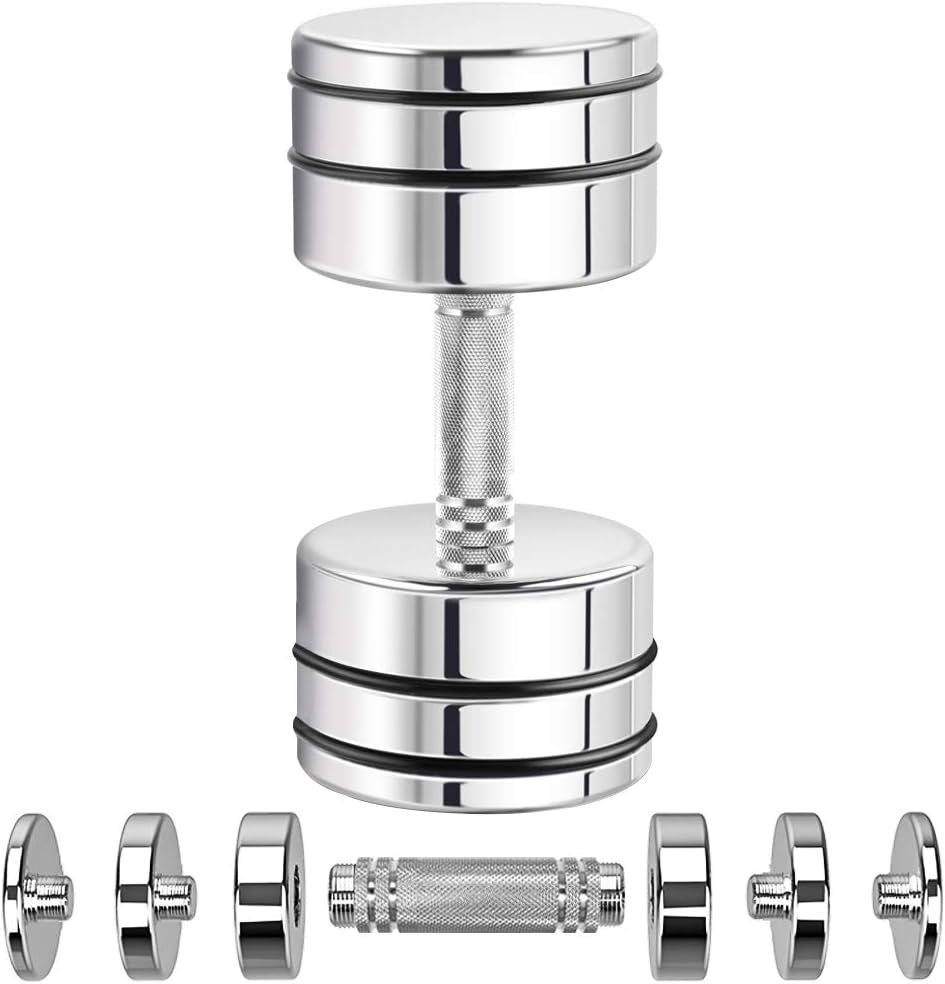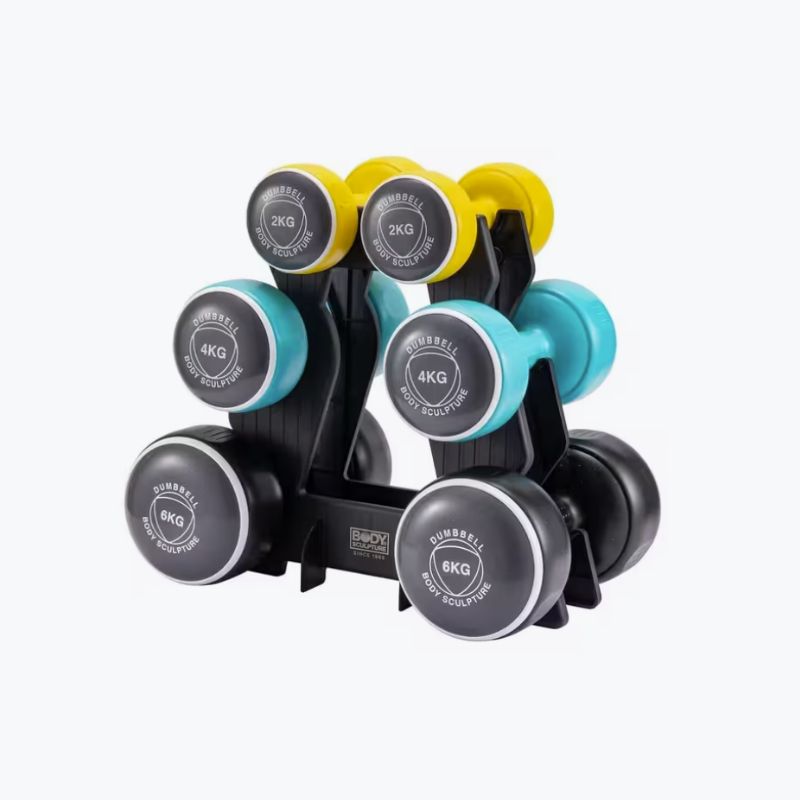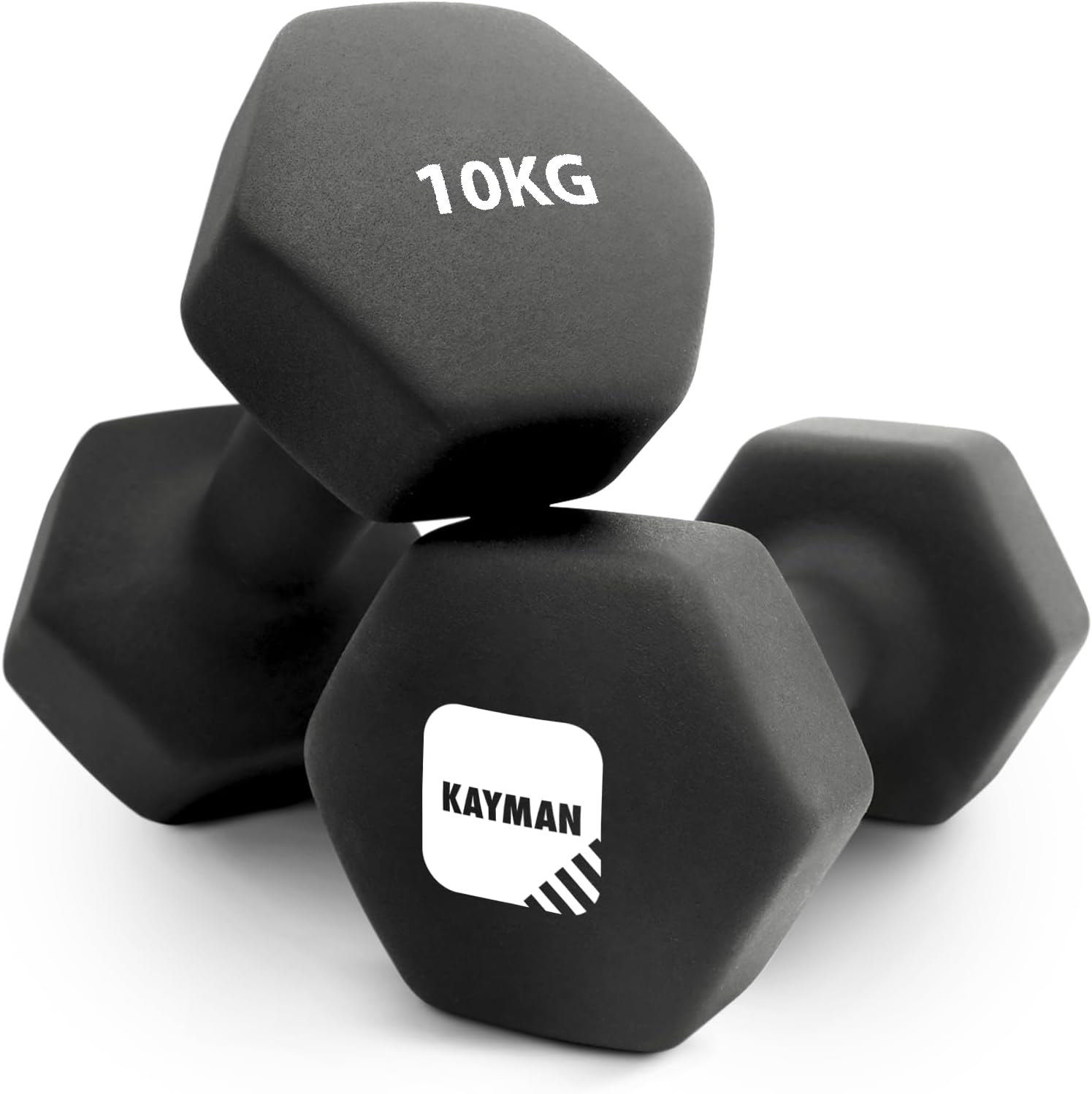Over 40? This 6-move dumbbell workout is all you need to start boosting strength and mobility at home
It's important to start strength training as early as possible before menopause, and a simple dumbbell workout like this does the job perfectly from home


From the age of 30, we start to lose muscle mass at a rate of three to five per cent per decade. It might sound worrying, but a simple dumbbell workout at home for 20 minutes or more can make all the difference.
Of all the weights you could choose, a set of the best dumbbells is going to be the most versatile at home, says Nelea Plescan, a certified personal trainer and strength specialist at Ultimate Performance. Nelea, who is in her 40s, says that unlike kettlebells or a barbell at the gym, these handheld weights offer an unrestricted range of motion. "For example, if you're performing a dumbbell shoulder press, you aren't only pushing the weight upwards, you're also stopping it from falling sideways," she says.
"Dumbbell exercises distribute resistance across more muscle groups than machines, and a greater range of motion will certainly help increase mobility in your joints," she says.
Whether you've been working out for years and looking for an at-home routine or want a dumbbell workout for beginners, PT Nelea has you covered with these six moves. All you need are some weights.
Dumbbell workout at home
1. Dumbbell split squat
The split squat is an "absolute must" for any woman wanting one of the best quadricep exercises to boost lower-body strength and build muscle (i.e. 'tone') in this area. "While not a completely unilateral exercise, it will help build balance and even development in each leg. It also targets the glutes (buttocks)," she says.
Here's how to do a split squat with dumbbells:
- Stand in an open space with your feet shoulder-width apart, dumbbells by your sides with your palms facing in.
- Step backwards and place your toes on the floor, with shoelaces facing down and heel raised. This is the start and end position for each rep.
- Drop your back knee down towards the floor and drive your front knee forward to close the gap between your hamstrings (back of your thigh) and calf.
- At the bottom of the split squat, your front foot should be flat and your back knee bent at 90 degrees, sitting a couple of inches away from the floor.
- Pause for a moment, keeping your upper body braced and the tension in your legs.
- Push through the front leg to reverse the movement and return to the starting position.
- Repeat for 6 to 8 reps.
Expert tip: If you struggle with the movement, try lifting the front heel with a wedge (like a book), suggests Plescan. This can allow for a greater range of motion if you lack ankle flexibility, which is a common problem.
Sign up to our free daily email for the latest royal and entertainment news, interesting opinion, expert advice on styling and beauty trends, and no-nonsense guides to the health and wellness questions you want answered.

Adjustable dumbbells are money and space-saving alternatives to singular weights, and I'd recommend them to anyone who wants to do a dumbbell workout at home. You simply switch the plates in and out to take the weight up or down.

Ranging from 2kg to 6kg, this is a perfect starter set for those doing a dumbbell workout as a beginner and looking for lighter weights. The handy rack helps store the weights out of the way as well.

Dumbbells are undoubtedly an expense, so opting for a budget-friendly set is a good way to try out the workout before fully committing. This set is under £40 for a 10kg pair, comes with speedy delivery, and is heavy enough to help you get stronger.
2. Dumbbell shoulder press
A high-incline or shoulder press is Plescan's go-to exercise in any upper-body dumbbell workout for boosting functional strength. Think of all the times you'll need to lift something above your head - this exercise helps with that as you age.
Here's how to do it:
- Stand with your feet shoulder-width apart with your dumbbells by your sides.
- Curl the dumbbells towards you so they are level with your shoulders. Your wrist, elbow, and shoulders are all aligned.
- Point your chest up and tuck your shoulder blades back and down, as if you're putting them into your back pockets. Keep your ribcage tucked down. This is the start and end of the movement.
- Press both dumbbells towards the ceiling until your arms, shoulders, hips, and thighs are all in alignment.
- Slow and controlled, bring them back down until you can't lower them anymore without your shoulders rounding in.
- Repeat for 6 to 8 reps.
Expert tips: It can be tempting to 'touch' the dumbbells together at the top of the movement, so you know you're at the top, but try to avoid doing this.
"Also, ensure you don't 'shrug' the weight at the top. This reduces shoulder stability and increases the risk of injury," says Plescan. "Focus on keeping the shoulder blades tucked down throughout."
3. Dumbbell Romanian deadlift
"Increasing the strength and size of the glutes and hamstrings helps stabilise the hips and builds speed and power in exercises like sprinting," says Plescan.
Here's how to do a Romanian deadlift with dumbbells:
- Stand upright, holding a dumbbell in each hand in front of your body, palms facing towards you, and your feet shoulder-width apart.
- Tuck your shoulder blades back and down. There should be a soft bend in your knees and the dumbbells should be lightly touching your thighs.
- Look at the floor just in front of you to prevent any movement of the spine.
- Push your hips back and bend forward at the hips, keeping your back straight and shoulder blades tight.
- Lower the dumbbells as far as possible until you feel a stretch in your hamstrings. You have reached the end of your range-of-motion when you can go no further without the lower back rounding or the knees moving, says the PT.
- Pause for a moment here, before driving your hips forward and squeezing your glutes. Try to 'press' the weight upwards with your feet, rather than yank the upper body.
Expert tips: The key to a dumbbell deadlift is to bend from the hips rather than your lower back. Pretend like you're trying to press a button on the wall behind you with your glutes.
Remember to "protect your armpits" too, says the PT. This note will help you remember to keep your shoulder blades and the upper back muscles (latissimus dorsi, 'lats') tight.
This is also one of the best exercises for longevity, as the lower body muscles are used for many daily movements, like getting up from a chair or climbing stairs.
4. Dumbbell lateral raise
The lateral raise targets the muscles on the sides of your shoulders. For this movement, "to keep healthy shoulders", you'll need a lighter pair of dumbbells compared to the ones you'd use for the shoulder press. The focus is on maximum control.
Here's how to do a dumbbell lateral raise:
- Grab a pair of dumbbells and stand up straight with the weights by your sides, palms facing your body.
- Raise the dumbbells out to the sides in a controlled manner, finishing the movement when you get to shoulder height.
- At the top, slowly lower the weights back down to your sides, not letting the dumbbells touch your body.
- Repeat the movement.
Expert tip: "Your knuckles should also be facing the ceiling once you have raised the dumbbells to shoulder height," she says.
5. Dumbbell row
The dumbbell row is one of the best back exercises. With age, it's important to work all the muscles in the back of the body, as these help support the spine as you move. Strong back muscles will also help improve your posture.
Here's how to do the bent-over row:
- Hold the weights by your side with a neutral grip.
- Bend your legs and lean your torso towards the floor, creating a 45-degree angle between your hips and your upper body/back.
- Holding the dumbbells, let your arms hang fully extended by your sides, with your palms facing inwards. This is the start and end position for each rep.
- Pinch your shoulder blades together, keeping your elbows pointed out at a 45-degree angle.
- When your shoulder blades can't move back any more without your shoulders rotating in and your upper back rounding over, you've reached the end of the movement.
- Pause for a moment, focusing on contracting your upper back muscles.
- Reverse the movement and return to the start position.
- Repeat the exercise for 6 to 8 reps.
6. Dumbbell goblet squat
The dumbbell goblet squat is a common feature in a gym dumbbell workout. Many people use a weight plate from a squat rack to lift their heels off the floor, making this movement easier. At home, you can use a book or a wedge of some kind.
The exercise targets the lower body, including the quadriceps (thighs) and glutes (buttocks), as well as the calves, and it helps to improve ankle mobility.
- Stand with your feet hip-width apart, chest up, and core engaged. With both hands, hold the dumbbell in front of your chest like a goblet, using your palms under the head of the weight rather than holding the handle.
- Keep your back straight and your core engaged.
- Sit your hips back and bend your knees, lowering yourself down into a squat position. Track your knees over your toes.
- Try to squat so your knees are parallel or lower to fully engage all the muscles in your lower body.
- Keeping the weight in the heels, straighten the knees and drive the hips back to the starting position and contract the glutes.
- Repeat the exercise for 6 to 8 reps.
Expert tips: "Keep tension in the legs and glutes throughout the set by not locking out at the top of the squat," says Plescan.
What weight should you use?
If you're doing weight-bearing exercises to prevent osteoporosis risk, which increases with age and the onset of perimenopause symptoms, you need to go heavy with your weights. It should be heavy enough that you can do a few repetitions, but you should be struggling on the final one.
It's important to choose a weight that's challenging enough so your muscles really have to work to lift it. This is what helps break down the tiny fibres that repair and grow stronger, warding off conditions like osteoporosis (as the muscles pull against the bone) and sarcopenia (muscle loss).
However, Nelea warns it's still essential to "focus on mastering your form" with every movement. "Executing each rep perfectly, with good control, is the safest and most effective way to exercise with weights."
If you need any help with your workout routine, consult a personal trainer.
Can you workout at home with only dumbbells?
Absolutely! Plescan says you can "most definitely put together some extremely challenging workouts using nothing more than a set of dumbbells" as they are the "most universal items to use at home".
You can use a dumbbell workout at home for building strength, muscle tone, fat loss, and general health and injury rehabilitation, she says. A dumbbell core workout will also help build core strength.
"When you’re lifting weights, your body doesn’t know whether you’re using barbells, dumbbells, resistance bands, machines, rocks or even carrier bags filled with tinned cans," she says. "All the body experiences are the resistance these weights provide, and the tension your muscles generate to move the load, which is the primary stimulus for building and developing muscle tissue."
However, you have to make the exercises more challenging as you improve in strength and mobility, a concept known as progressive overload. To do this, you'll need dumbbells that go up in weight, or handily, you can also buy adjustable dumbbells that flick in and out of various weights with just one set.

Grace Walsh is woman&home's Health Channel Editor, working across the areas of fitness, nutrition, sleep, mental health, relationships, and sex. She is also a qualified fitness instructor. In 2025, she will be taking on her third marathon in Brighton, completing her first ultra marathon, and qualifying as a certified personal trainer and nutrition coach.
A digital journalist with over seven years experience as a writer and editor for UK publications, Grace has covered (almost) everything in the world of health and wellbeing with bylines in Cosmopolitan, Red, The i Paper, GoodtoKnow, and more.
You must confirm your public display name before commenting
Please logout and then login again, you will then be prompted to enter your display name.